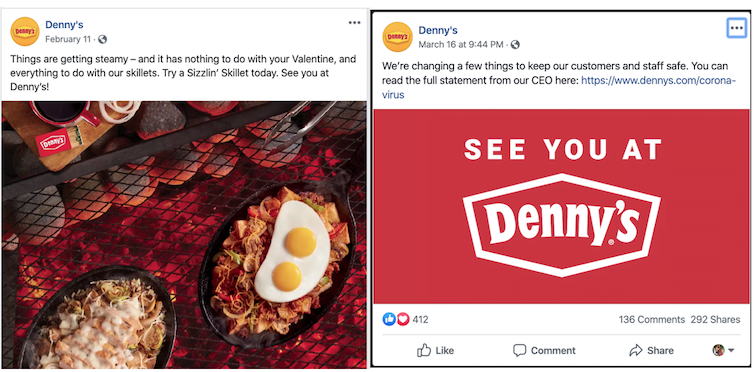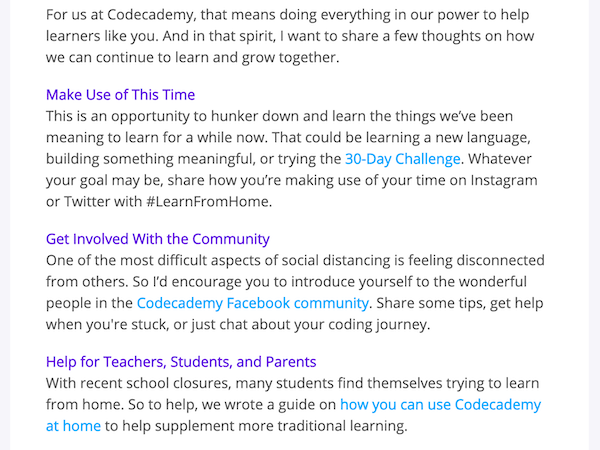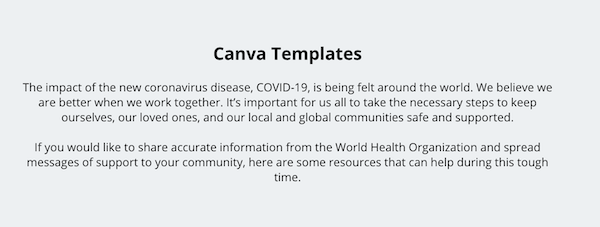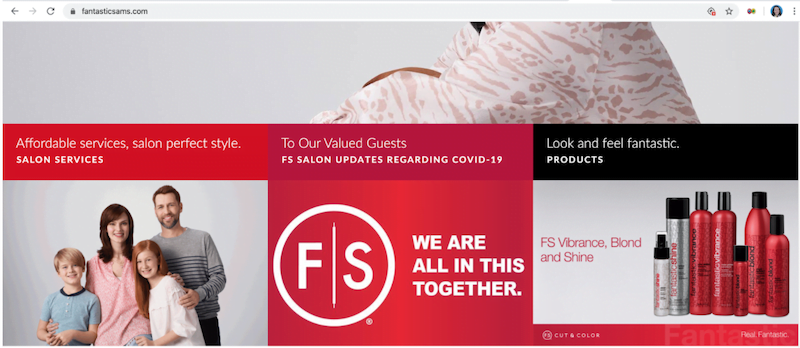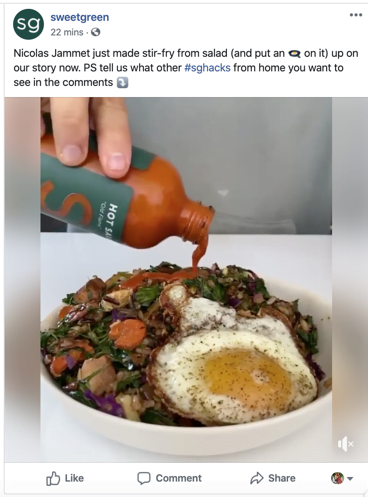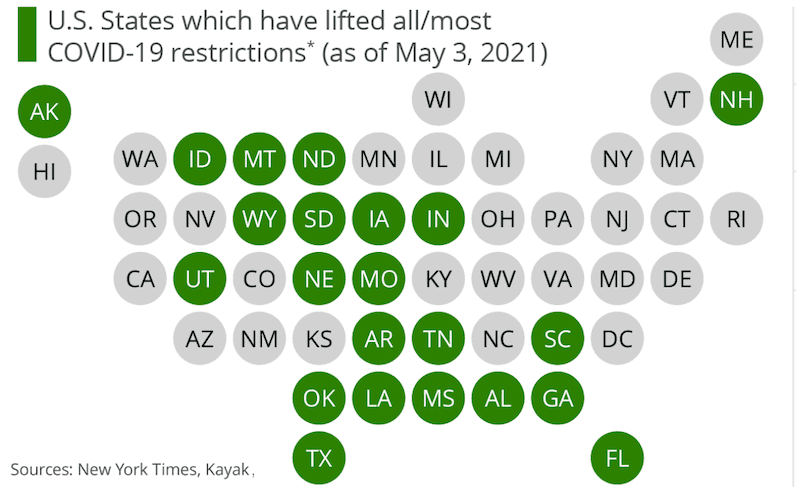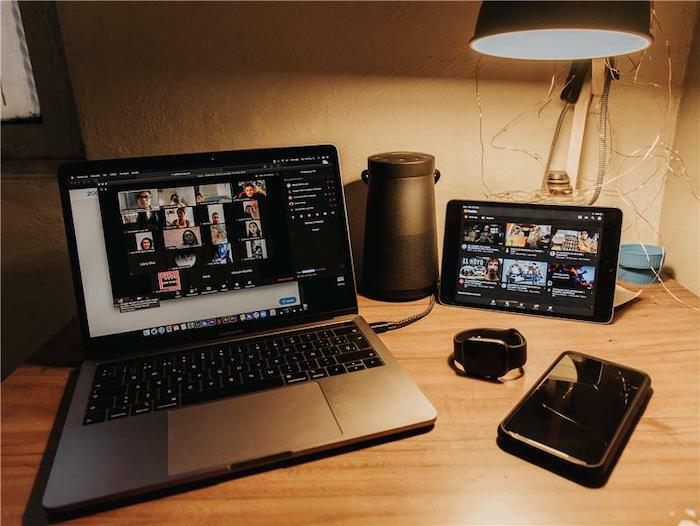
The COVID-19 outbreak has affected all aspects of our lives, including marketing. Even if your business is not health-related, you are most likely incorporating the pandemic into your content and messaging. Yet you are also most likely trying to figure out exactly how to stay relevant while also appropriate during such an unprecedented time. This guide was written to help you with that. It includes:
- Guidelines for staying sensitive
- Resources for ensuring accuracy
- Suggestions for modifying your offers
- Tips for keeping track of it all
COVID-19 has not only shifted business trends, but also consumer priorities and the entire marketing landscape. The goal of this guide is to help you adapt your messaging accordingly so you can continue purposeful, quality communication with your audience and stand strong with your customers. Let’s start with the most important one.
Being sensitive
COVID-19 has impacted individuals on a personal level world-wide, so the risk of inadvertently coming off as insensitive or even exploitative is higher than ever right now. And with social media communication at a peak, one small mistake could mean far-reaching and long-term consequences for you. Follow these guidelines to make sure you’re communicating appropriately during the COVID-19 outbreak.
Better too serious than sorry
While it’s normally common and effective for brands to keep a conversational tone, it’s best to steer clear of using humor or wit to accomplish that right now. Even being overly casual can be off-putting. Your content may not be as colorful or aligned with your brand personality, but it’s far better to be more serious than you want to be than to be more sorry than you can express.
We recommend keeping a positive, inspirational, and helpful tone. Avoid being humorous, witty, or casual.
Denny’s provides a good example of deviating from their normally playful
and pun-filled tone (see left) to a more serious one (right).
There’s a right way to make light of the situation
Being more serious doesn’t mean somber. You can still stress the bright side; just know the difference between positivity and humor, and between being uplifting vs dismissive of the situation.
An appropriately uplifting email relevant to COVID-19.
Check for insensitive words
You know not to use overt puns, but keep in mind that there are several words and phrases that prior to COVID-19 were completely harmless. For example:
- Killer (as in a “killer deal”)
- Contagious (“how to create contagious content”)
- Health or checkup-related terms (“give your budget a pulse check”)
- Spread
- Contagious
- Infectious
- Viral
- Gather
- Event
Take a neutral or supportive stance
If your business is still operating and relevant, be careful with your positioning. For example, among the Federal government’s COVID-19 measures is a steep interest rate cut. For mortgage brokers, “Take advantage of the low interest rate now!” conveys an inappropriately exciting message. On the other hand, “Let us help you navigate the unstable economy” offers security and respects the gravity of the situation.
Similarly, marketing and advertising agencies reaching out to these businesses should take a position not of helping businesses to “capitalize” on the current times, but rather of helping them to make themselves as visible/accessible as possible right now to those who need them.
- Use: “contribute,” “connect,” “play a role,” “navigate,” “cope,” “respond”
- Do not use: “capitalize,” “advantage,” “offer,” “gain,” “profit”
- Be careful with: “opportunity,” “make the most”
Think contribution, not conversion
If you’re one of the less or non-essential businesses with respect to COVID-19, there are still ways to stay relevant. However, your motive here should not be to get more business but to continue offering value to your audience. People are just trying to say afloat right now, so think contribution, not conversion.
I recently received an email from CodeAcademy that embodies the contribution approach. Here is a snippet from their email:
This is not the time to convert customers but to contribute to the COVID-19 response.
Questions for Kristen? Register here for a live Q&A!
Ensuring accuracy
Now more than ever, taking the extra steps to stay accurate will help you to maintain the trust you’ve worked so hard to build with your audience. It will also help you to keep up with changing search trends and even filter out any unreliable COVID-19 resources of your own. Here are some guidelines and resources to help you stay accurate.
Navigate the changing online advertising landscape with this free small business guide to COVID-19.
Use credible COVID-19 sources
Effective copywriting provides information while simultaneously delivering a greater message. Your intended message may be “I am here to help you,” but if your information is inaccurate, this is not the message that will come through. At best it will say “I’m careless,” and at worst, “I can’t be trusted.”
Inaccurate information about the coronavirus is everywhere, so make sure you get your facts straight when copywriting—especially for social media captions or ads that can get shared. The best places for reliable information are:
- Centers for Disease Control
- World Health Organization
- The Department of Public Health for your state
- Factcheck.org’s Coronavirus Coverage Guide
In an effort to minimize the spread of inaccurate information, Canva came up with a range of free print and social media templates using information from the World Health Organization. You can access their Coronavirus Awareness Collection here. Their messaging around providing these templates is also on par with the suggestions in this guide:
Canva demonstrates sensitive messaging, contribution-focused positioning, and accuracy of information.
Employ proper grammar
Checking for grammar is a no-brainer when it comes to copywriting, but it’s especially important when it comes to COVID-19. Improper grammar can undermine the validity of your facts, and even alter your message. For example, “the governor put a shelter in place for the city” actually means a shelter was put into place and even implies a gathering. Small details matter. To clarify, for this example:
- Shelter in place is a verb (action): “We advise you to shelter in place.”
- Shelter-in-place is an adjective (description): “We’ve instated a shelter-in-place policy.”
And for your coronavirus-related copywriting in general, there are two great tools that we can suggest:
- Topical Guide on COVID-19: This simple yet super-helpful guide was created by the Associated Press to help with coverage of the coronavirus.
- Grammarly: This is a contextual editor that catches important fixes that slip past regular spell check. It’s a free plugin you can download and use across all applications.
Checking up on details like this takes some extra time, and maybe your audience will know what you meant, but better to be safe than sorry. Plus, COVID-19 isn’t a trending topic; its effects are going to be long-lasting, so your content is likely to stay relevant for a while. Make sure it’s as up to standard as the rest of your copywriting.
Stay optimistic, but don’t overpromise
It’s important to inspire hope and forward-thinking through your copywriting, but remember that this is an unprecedented situation; even expert predictions have questionable accuracy. All that you can promise your audience is that you’ll stay committed to handling the situation and serving them the best way you can. Ensuring anything else, even if to keep up morale, could backfire on you.
Modifying your offers
Google has banned advertising on travel-related services, but there are still a lot of businesses that can, and should, advertise relevant services during COVID-19. Just make sure to modify your copywriting so that calls to action are appropriate. Also, keep in mind that things are evolving fast, so keep your messaging as versatile as possible so you don’t have to be constantly updating your copy. Here are some guidelines and suggestions for CTAs with respect to COVID-19.
Ease up on urgency
“Call now” or “Book now” buttons are fine; but excitement- or scarcity-driven copywriting, like “Don’t miss out!” or “Grab your spot before it’s too late!” is not going to resonate with consumers or businesses right now. Nothing is as urgent as COVID-19, and this type of tone is more likely to cause you to come off as unaware or ignorant.
A nice example of adjusting messaging away “book now” urgency
Adjust for relevance
Check your offerings and make sure your copy is aligned with COVID-19 safety measures, lifestyle changes, and search trends. For example:
- Change irrelevant value propositions like “more dog walks” or “more diners in your doors” to something more neutral, like “more leads,” or more timely, like “more online orders.”
- Reword inapplicable CTAs, like “join now” for facilities that are closed. “Learn more” could work here.
- Use words to reinforce the safety of your audience, such as “contact-free,” “virtual,” “remote,” “in-home,” “downloadable,” “delivery,” “online.”
Sweetgreen has modified #sghacks to #sghacks from home
Coolidge Yoga has made appropriate COVID-19 adjustments with a virtual offering.
Check your scheduled content
Don’t forget to check your automated emails or scheduled posts for relevance and appropriateness. This may include:
- April Fools humor
- Easter gathering-related content
- Birthday or anniversary offers
- Automated nurture campaigns
Staying on track
If you’re feeling overwhelmed with all of the changes you need to make to your copy, just remember that you’re not alone. Everyone is having to make adjustments right now and settling into new rhythms. Here are some tips to help you through.
- Prioritize. You won’t (and shouldn’t) make the above changes to all of your copy. Start with top-trafficked content and new content moving forward.
- Track your changes: Create a spreadsheet of the changes you make so you can keep track of what to change back when things start to settle out.
- Don’t delete anything: Save your good ideas and well-performing campaigns for reinstatement in the future when they will be more effective. Things will return to normal someday. A new normal, but a normal nonetheless.
Maintain your copywriting standards while marketing during COVID-19
Adapting your ads and strategies during the ever-shifting COVID-19 situation is tricky. However, while your messaging and offers may change, your copywriting standards should be the same. At the end of the day, you are still supplying information, adding value, and conveying to your audience that you are in tune with their needs.

